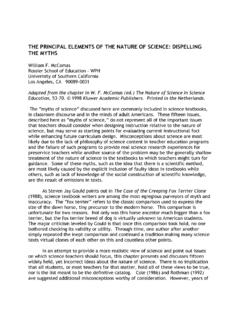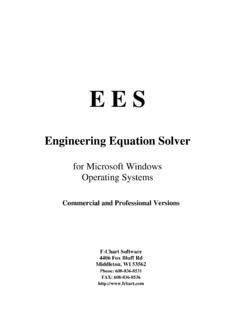Transcription of Introduction To Physical Oceanography
1 Introduction ToPhysical OceanographyRobert H. StewartDepartment of OceanographyTexas A & M UniversityCopyright 2006 September 2006 EditioniiContentsPrefacevii1 A Voyage of Physics of the ocean .. Goals .. Organization .. The Big Picture .. Further Reading .. 52 The Historical Definitions .. Eras of Oceanographic Exploration .. Milestones in the Understanding of the Ocean .. Evolution of some Theoretical Ideas .. The Role of Observations in Oceanography .. Important Concepts .. 203 The Physical Ocean and Seas .. Dimensions of the ocean .. Sea-Floor Features .. Measuring the Depth of the Ocean .. Sea Floor Charts and Data Sets .. Sound in the Ocean .. Important Concepts .. 374 Atmospheric The Earth in Space.
2 Atmospheric Wind Systems .. The Planetary Boundary Layer .. Measurement of Wind .. Calculations of Wind .. Wind Stress .. Important Concepts .. 49iiiivCONTENTS5 The Oceanic heat The Oceanic heat Budget .. heat -Budget Terms .. Direct Calculation of Fluxes .. Indirect Calculation of Fluxes: Bulk Formulas .. Global Data Sets for Fluxes .. Geographic Distribution of Terms .. Meridional heat Transport .. Variations in Solar Constant .. Important Concepts .. 726 Temperature, Salinity, and Definition of Salinity .. Definition of Temperature .. Geographical Distribution .. The Oceanic Mixed Layer and Thermocline .. Density .. Measurement of Temperature .. Measurement of Conductivity or Salinity .. Measurement of Pressure.
3 Temperature and Salinity With Depth .. Light in the Ocean and Absorption of Light .. Important Concepts .. 1007 The Equations of Dominant Forces for Ocean Dynamics .. Coordinate System .. Types of Flow in the ocean .. Conservation of Mass and Salt .. The Total Derivative (D/Dt) .. Momentum Equation .. Conservation of Mass: The Continuity Equation .. Solutions to the Equations of Motion .. Important Concepts .. 1148 Equations of Motion With The Influence of Viscosity .. Turbulence .. Calculation of Reynolds Stress: .. Mixing in the Ocean .. Stability .. Important Concepts .. 132 CONTENTSv9 Response of the Upper Ocean to Inertial Motion .. Ekman Layer at the Sea Surface .. Ekman Mass Transport .. Application of Ekman Theory.
4 Langmuir Circulation .. Important Concepts .. 14710 Geostrophic Hydrostatic Equilibrium .. Geostrophic Equations .. Surface Geostrophic Currents From Altimetry .. Geostrophic Currents From Hydrography .. An Example Using Hydrographic Data .. Comments on Geostrophic Currents .. Currents From Hydrographic Sections .. Lagrangian Measurements of Currents .. Eulerian Measurements .. Concepts .. 18111 Wind Driven Ocean Sverdrup s Theory of the Oceanic Circulation .. Western Boundary Currents .. Munk s Solution .. Observed Circulation in the Atlantic .. Important Concepts .. 19712 Vorticity in the Definitions of Vorticity .. Conservation of Vorticity .. Influence of Vorticity .. Vorticity and Ekman Pumping .. Important Concepts .. 21013 Deep Circulation in the Defining the Deep Circulation.
5 Importance of the Deep Circulation .. Theory for the Deep Circulation .. Observations of the Deep Circulation .. Antarctic Circumpolar Current .. Important Concepts .. 23214 Equatorial Equatorial Processes .. El Ni no .. El Ni no Teleconnections .. Observing El Ni no .. Forecasting El Ni no .. Important Concepts .. 25215 Numerical Introduction Some Words of Caution .. Numerical Models in Oceanography .. Global Ocean Models .. Coastal Models .. Assimilation Models .. Coupled Ocean and Atmosphere Models .. Important Concepts .. 26916 Ocean Linear Theory of Ocean Surface Waves .. Nonlinear waves .. Waves and the Concept of a Wave Spectrum .. Ocean-Wave Spectra .. Wave Forecasting .. Measurement of Waves .. Important Concepts .. 29117 Coastal Processes and Shoaling Waves and Coastal Processes.
6 Tsunamis .. Storm Surges .. Theory of Ocean Tides .. Tidal Prediction .. Important Concepts .. 312 References313 PrefaceThis book is written for upper-division undergraduates andnew graduate stu-dents in meteorology, ocean engineering, and Oceanography . Because these stu-dents have a diverse background, I have emphasized ideas andconcepts morethan mathematical most books, I am distributing this book for free in digital format viathe world-wide web. I am doing this for two reasons:1. Textbooks are usually out of date by the time they are published, usuallya year or two after the author finishes writing the book. Randol Larson,writing inSyllabus, states: In my opinion, technology textbooks are awaste of natural resources. They re out of date the moment they arepublished. Because of their short shelf life, students don t even want tohold on to them (Larson, 2002).
7 By publishing in electronic form, I canmake revisions every year, keeping the book Many students, especially in less-developed countries cannot afford thehigh cost of textbooks from the developed world. This then isa giftfrom the US National Aeronautics and Space Administrationnasato thestudents of the have taught from the book for several years, and I thank the many studentsin my classes and throughout the world who have pointed out poorly writtensections, ambiguous text, conflicting notation, and other errors. I also thankProfessor Fred Schlemmer at Texas A&M Galveston who, after using the bookfor his classes, has provided extensive comments about the also wish to thank many colleagues for providing figures, comments, andhelpful information. I especially wish to thank Aanderaa Instruments, KevinBartlett, Don Chambers, Gerben de Boer, Daniel Bourgault, Richard Eanes,Gregg Foti, Nevin S.
8 Fu ckar, Luiz Alexandre de Araujo Guerra, Hazel Jenkins,Judith Lean, Christian LeProvost, Brooks Martner, NikolaiMaximenko, KevinMcKone, Mike McPhaden, Pim van Meurs, Gary Mitchum, Peter Niiler, Is-mael N u nez-Riboni, Alex Orsi, Mark Powell, Richard Ray, Joachim Ribbe, WillSager, David Sandwell, Sea-Bird Electronics, Achim Stoessel, David Stooksbury,Tom Whitworth, Carl Wunsch and many course, I accept responsibility for all mistakes in the book. Please sendme your comments and suggestions for in the book came from many sources. I particularly wish to thankLink Ji for many global maps, and colleagues at the University of Texas Centerfor Space Research. Don Johnson redrew many figures and turned sketches intofigures. Trey Morris tagged the words used in the especially thanknasa s Jet Propulsion Laboratory and the Topex/Poseidonand Jason Projects for their support of the book through contracts 960887 photograph of an island in the Maldives was taken by Jagdish Agara(copyright Corbis).
9 Cover design is by Don book was produced in LATEX2 using TeXShop on a dual-processorMacintosh G4 computer running OS-X I especially wish to thank GerbenWierda for his very useful i-Installer package that made it all possible, andRichard Koch, Dirk Olmes and many others for writing the TeXShop softwarepackage. Their software is a pleasure to use. All figures weredrawn in 1A Voyage of DiscoveryThe role of the ocean on weather and climate is often discussed in the has not heard of El Ni no and changing weather patterns, the Atlantichurricane season and storm surges? Yet, what exactly is the role of the ocean?And, why do we care? Why study the Physics of the ocean?The answer depends on our interests, which devolve from our use of theocean. Three broad themes are important:1. We get food from the ocean.
10 Hence we may be interested in processeswhich influence the sea just as farmers are interested in the weather andclimate. The ocean not only has weather such as temperature changesand currents, but the oceanic weather fertilizes the sea. The atmosphericweather seldom fertilizes fields except for the small amountof nitrogenfixed by We use the ocean. We build structures on the shore or just offshore. Weuse the ocean for transport. We obtain oil and gas below the ocean. And,we use the ocean for recreation, swimming, boating, fishing,surfing, anddiving. Hence we are interested in processes that influence these activities,especially waves, winds, currents, and The ocean influence the atmospheric weather and climate. The oceaninfluence the distribution of rainfall, droughts, floods, regional climate,and the development of storms, hurricanes, and typhoons.









